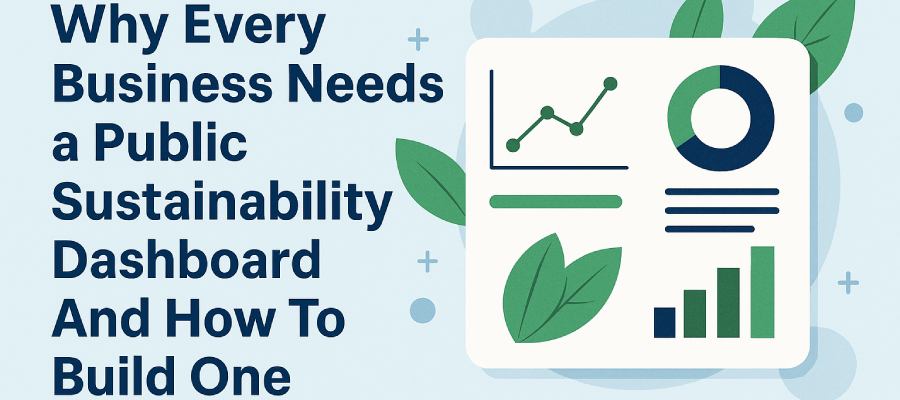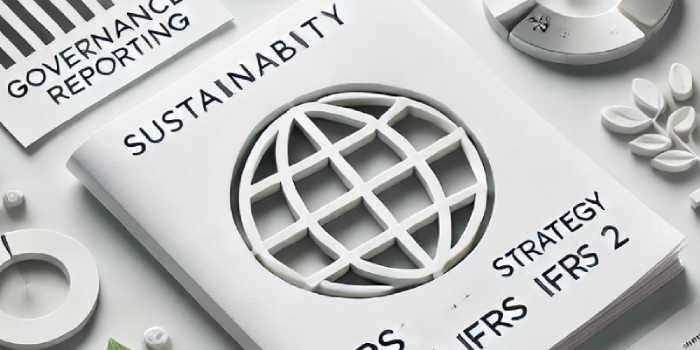Why Every Business Needs a Public Sustainability Dashboard And How To Build One

The demand for transparency around environmental, social, and governance (ESG) issues has moved beyond the boardrooms of global corporations. Today, businesses of all sizes are expected to show real, measurable progress toward sustainability goals. Whether you’re running a tech startup, a real estate firm, or a boutique hotel, your stakeholders—customers, employees, investors, regulators—want to see evidence, not just promises.
A public sustainability dashboard provides a tangible way to demonstrate your commitment to ESG values. It doesn’t just display metrics; it tells a story about your company’s values, impact, and vision for the future. More than a reporting tool, it becomes part of your brand narrative, showing stakeholders that your business is serious about contributing to a more sustainable and equitable world.
In this article we review everything you need to know about building a public sustainability dashboard, including how to get started without a large ESG team and how FolioProjects can streamline the process for any organization.
Table of Contents
-
What Is a Public Sustainability Dashboard?
-
Why Businesses Need Sustainability Dashboards
-
What Should You Track on Your Dashboard?
-
Key Features of Effective Sustainability Dashboards
-
Building a Dashboard Without a Big ESG Team
-
Promoting and Embedding Your Dashboard
-
Using FolioProjects to Launch a Real-Time Sustainability Dashboard
-
Conclusion: Transparency Is the New Competitive Advantage
What Is a Public Sustainability Dashboard?
A public sustainability dashboard is a digital interface that displays real-time or regularly updated information on your business’s environmental, social, and governance (ESG) metrics. It acts as a transparent reporting tool that anyone can view—from customers to community members to regulators.
Typically embedded into your website or shared as a link, a dashboard presents data like:
-
Carbon footprint and emissions reductions
-
Energy or water usage
-
Waste diversion rates
-
Diversity and inclusion metrics
-
Volunteer hours or donations
-
Sustainability project progress
By displaying this information publicly, businesses show they are walking the talk when it comes to sustainability.
Why Businesses Need Sustainability Dashboards
The benefits of a sustainability dashboard extend far beyond checking a compliance box. For one, they act as a powerful trust-building tool. Customers are increasingly making purchasing decisions based on a company’s values and practices. A visible, up-to-date dashboard shows that your business has nothing to hide and plenty to be proud of.
Investors are also paying closer attention to ESG performance. As environmental risks become financial risks, investors use ESG indicators to assess the long-term viability of companies. A dashboard provides a straightforward, digestible view of your sustainability strategy and progress, making it easier to win confidence and support.
Internally, dashboards foster better decision-making. Teams gain a clear understanding of what’s working, what needs adjustment, and how their roles tie into broader sustainability goals. Externally, they can be a differentiator in marketing, showcasing initiatives that set your brand apart.
Even in the absence of mandatory ESG disclosure laws, being proactive with public reporting puts your company ahead of the curve—and sends a message that you’re ready for the future.
Some popular reasons for adopting ESG dashbaords include the following:
- Stakeholder Trust Modern consumers demand authenticity. A public dashboard shows you aren’t just making green claims—you’re backing them with data.
- Attracting Investors and Partners Many investors now evaluate ESG data during due diligence. Dashboards offer an accessible summary of performance.
- Improved Decision-Making Dashboards help teams track KPIs in real time and make informed decisions about operational improvements.
- Marketing and Differentiation Use your dashboard in campaigns to highlight sustainability wins. Few competitors are this transparent—giving you an edge.
- Regulatory Readiness Even if you're not yet required to report ESG metrics, being prepared now puts your business ahead of emerging compliance demands.
What Should You Track on Your Dashboard?
The best dashboards don’t try to show everything—they show what matters most. A focused set of metrics makes your data more understandable and useful.
Environmental Metrics:
-
Electricity consumption (kWh)
-
Renewable energy usage (% of total)
-
CO2 emissions (tons)
-
Waste diverted from landfill (kg or %)
Social Metrics:
-
Team demographics (gender, race, age)
-
Employee volunteer hours
-
Charitable donations
-
Community engagement stats
Governance Metrics:
-
Board diversity
-
ESG policy adoption
-
Compliance reporting progress
Project-Based Metrics:
-
Milestones on key sustainability initiatives
-
Feedback from stakeholders (via tools like HueFlux)
Use visuals (like pie charts and progress bars) to make the data easy to digest.
Key Features of Effective Sustainability Dashboards
An effective dashboard is more than just a spreadsheet with a few charts. It’s a communication tool that should engage, educate, and inspire your stakeholders. That requires attention to both design and functionality.
Not all dashboards are created equal. The best ones share a few critical characteristics:
- Clear and Simple Design Avoid overwhelming users with too much data. Focus on the top 5–10 metrics.
- Real-Time or Regular Updates Outdated data erodes trust. Use a platform that can update easily.
- Mobile-Friendly Stakeholders will check your dashboard on mobile. It must work seamlessly on any screen.
- Easy to Share and Embed Include a shareable link, embed code, or QR code to increase visibility.
- Action-Oriented Insights Use plain language to explain what your metrics mean and how they relate to your goals.
Simplicity is key. Your dashboard should feature a clean layout with intuitive navigation. Each metric should be clearly labeled and explained. Use graphics—such as pie charts, bar graphs, or interactive progress bars—to help users quickly understand the data.
Timeliness matters just as much as clarity. Outdated data can damage your credibility, so aim for real-time updates or at least quarterly refreshes. Platforms that automate this process are especially valuable.
Since mobile traffic dominates web usage, your dashboard must be fully responsive across devices. Embedding options like iframe codes or QR codes also allow you to place your dashboard in multiple locations—from your homepage to investor decks to event signage.
Perhaps most importantly, your dashboard should tell a story. Use short descriptions or tooltips to explain why each metric matters and what actions you’re taking to improve. This adds context and invites users to engage more deeply.
Building a Dashboard Without a Big ESG Team
You don’t need to hire a sustainability officer or a development agency to create a dashboard. Many small and medium-sized businesses are using lightweight, cost-effective tools to launch and maintain public-facing dashboards.
Small businesses often believe dashboards are out of reach due to:
-
Lack of ESG expertise
-
No data collection systems
-
Limited technical skills
But thanks to modern tools, that’s no longer true. Here are a few lean ways to get started:
- Pick 3-5 Metrics You Can Measure Today Start with what's easy to collect: electricity bills, donation receipts, headcount demographics.
- Use an All-In-One Tool Instead of hiring developers or analysts, use a platform like FolioProjects that does the heavy lifting.
- Build Momentum Over Time Your first dashboard version doesn’t need to be perfect. Publish a V1, then expand as you gather more data.
- Get Input From Stakeholders Use sentiment tracking to understand which metrics matter most to your audience.
Start with what you have. A few spreadsheets, your utility bills, and a simple staff survey can yield enough data to build a solid version one. Choose 3–5 metrics you can track consistently. Over time, you can layer in more complexity as your reporting processes mature.
The biggest obstacle for many businesses is the perception that ESG reporting is too technical. That’s where no-code platforms like FolioProjects come in. They eliminate the need for developers and allow you to publish a polished, professional dashboard in hours—not weeks.
Stakeholder input is also invaluable at this stage. Use sentiment analysis tools to learn what your customers or community care most about. Tailoring your dashboard to these priorities ensures it will resonate and drive engagement.
Promoting and Embedding Your Dashboard
A dashboard is only as powerful as the number of people who see and use it. To maximize impact, make sure your sustainability dashboard is not just buried in a submenu. Feature it prominently on your website’s homepage, About section, or Investor Relations page.
With FolioProjects provides multiple features for sharing your dashboards including dashboard links in your email signatures, newsletters, and company bios. If your team participates in trade shows or community events, print a QR code that links directly to the dashboard. You can even showcase it on screens in your physical locations or lobby displays.
Think of your dashboard as a storytelling asset. Use it in press releases, marketing campaigns, and social media posts to illustrate your progress. Every interaction is an opportunity to reinforce your ESG commitment.
You can go a step further by tracking dashboard visits and interactions. This data provides feedback on what’s working and can guide your content strategy
A dashboard won’t deliver value if no one sees it. Promotion and visibility matter.
Ways to Share Your Sustainability Dashboard:
-
Embed it on your homepage or About page
-
Link to it in email footers or investor presentations
-
Include it in ESG reports and grant applications
-
Print a QR code linking to the dashboard on brochures or signage
-
Highlight it in social media campaigns
Pro tip: Track how often people visit or interact with the dashboard to refine your content and strategy.
Using FolioProjects to Launch a Real-Time Sustainability Dashboard
FolioProjects was built for businesses looking to increase transparency, collect actionable data, and streamline stakeholder communication—all without hiring a tech team.
With FolioProjects, you can quickly publish a custom sustainability dashboard that evolves with your organization. Its built-in HueFlux sentiment engine captures real-time stakeholder feedback, giving you insights into how your ESG efforts are perceived.
The platform also generates QR codes and trackable links, making it easy to distribute your dashboard across print, digital, and in-person touchpoints. Broadcast Mode lets you cycle through project visuals, metric snapshots, and recent updates in a shareable format that fits anywhere from investor presentations to office TVs.
For businesses new to ESG reporting, FolioProjects provides templates and frameworks designed for different industries, from property management to nonprofits. This removes guesswork and helps you go live with confidence.
FolioProjects makes it simple to create, manage, and promote a real-time sustainability dashboard tailored to your business.
Key Features for Sustainability Reporting:
-
HueFlux Sentiment System: Collect real-time stakeholder feedback
-
QR Code Generator: Place QR codes in physical and digital materials
-
Trackable Links: Measure how people engage with your sustainability content
-
Broadcast Mode: Display your latest stats, photos, and project summaries
-
Templates for ESG Tracking: Easily customize dashboards for different industries
Whether you're a local non-profit, tech startup, or real estate developer, FolioProjects helps you create a shareable sustainability presence without hiring a development team.
Conclusion: Transparency Is the New Competitive Advantage
We’re entering an era where transparency is not just expected—it’s demanded. Consumers want to support companies that align with their values. Investors seek out businesses with long-term viability and responsible governance. Communities rally around organizations that demonstrate commitment through action.
A public sustainability dashboard gives you a powerful platform to meet all of these expectations. It helps you measure what matters, showcase your progress, and build lasting trust with those who matter most.
With FolioProjects, creating that dashboard is no longer a daunting technical challenge. It’s a strategic opportunity. Whether you’re just beginning your sustainability journey or ready to take your ESG reporting to the next level, now is the time to invest in visibility, credibility, and leadership.

